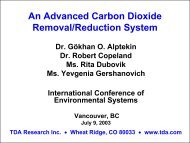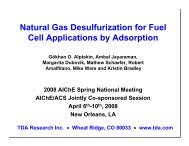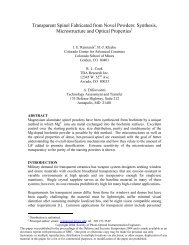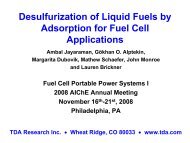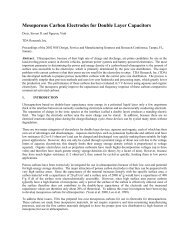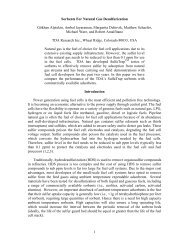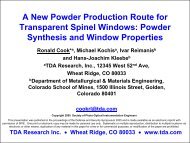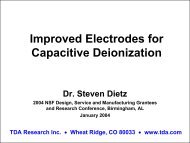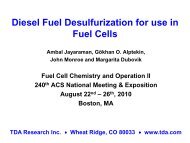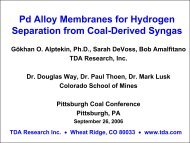SulfaTreat DO TDA's Direct Oxidation Technology for the Oil and ...
SulfaTreat DO TDA's Direct Oxidation Technology for the Oil and ...
SulfaTreat DO TDA's Direct Oxidation Technology for the Oil and ...
Create successful ePaper yourself
Turn your PDF publications into a flip-book with our unique Google optimized e-Paper software.
Outline• Background of sulfur recovery• <strong>Direct</strong> oxidation Field Test• Concept of <strong>SulfaTreat</strong> <strong>DO</strong>• Economics of <strong>the</strong> process• Market <strong>for</strong> technology• License to <strong>SulfaTreat</strong>• ConclusionsTDAR e s e a r c h
Commercial Sulfur Recovery Processes• Small (less than ~0.2 LTPD), H 2 S scavengers leastexpensive option, well proven• Medium (~0.2 to ~25 LTPD), aqueous-iron ‘liquidredox’ (well proven, “high” chemical costs)R‣ <strong>SulfaTreat</strong> <strong>DO</strong> is a medium scale process• Large (greater than ~25 LTPD) amine/Claus/TGTleast expensive, well proven but only economicalat large scalesTDAR e s e a r c h
Sulfur Recovery Plant SizesAmine/Claus/TGTR<strong>SulfaTreat</strong> <strong>DO</strong> to 50 TPDLiquid redox 0.2 – 25TPDScavengers alone < 0.2 TPD0 20 40 60 80 100 120 140 160 180 200Sulfur Capacity (tons/day)TDAR e s e a r c h
Small (< ~0.2 TPD)R• Scavengers (e.g. <strong>SulfaTreat</strong> ) are typically iron based• Scavenger must be very inexpensive• Only practical <strong>for</strong> small amounts of H 2STDAR e s e a r c h
Medium (~0.2 to ~25 TPD)SWEETGAS OUTVenturi contactorLO-CAT AbsorberAirLO-CATRegeneratorSULFURSoln pump(Shell/Westfield)RR• LO-CAT (GTP)• Sulferox• Cannot tolerate much SO 2• Sulfur removed from a slurry• Aqueous chelated Fe catalyst• Iron based liquid phase catalyst• Sulfur <strong>for</strong>m insoluble slurry• Cannot tolerate much SO 2• Liquid redox systems recover sulfur as slurry or solution• High chemical costs, somewhat complex to operateTDAR e s e a r c h
Large (> ~25 TPD)ACIDGASFEEDBypass <strong>for</strong> split flow operationAirBurnerWasteheatboilerSulfurcondenserClaus catalyst bedsTo tail gastreatmentBlowerSULFUR SULFUR SULFUR SULFUR• Claus process only economical at large scales (many licensors)• H 2S concentrated in an amine unit• Most of sulfur recovered during H 2S combustion in <strong>the</strong> furnace• Multiple reactors needed because Claus reaction is equilibrium limitedTDAR e s e a r c h
R<strong>SulfaTreat</strong> <strong>DO</strong> Process• TDA Research has developed a catalytic sulfurrecovery process that‣ Selectively oxidizes H 2 S to S <strong>and</strong> waterH 2 S + 0.5 O 2S + H 2 O‣ No equilibrium limitations because of good catalystselectivity‣ Recovers >90% of <strong>the</strong> H 2 S as S in a single step‣ Uses a patented catalyst‣ Has very low capital <strong>and</strong> operating costs‣ Can be directly operated on natural gas, syngas <strong>and</strong>hydrogen streams‣ Has a smaller footprint than liquid redox or Claus processesTDAR e s e a r c h
Steps to CommercializationKineticsConcept1996Proof ofconcept1996MicroreactorStudies1997-2000Catalystscale up2001•<strong>DO</strong>E/TDA funding <strong>for</strong> development•GTI funding <strong>for</strong> pilot fabrication•<strong>DO</strong>E funding <strong>for</strong> demonstration~ 1 toncatalystmanuf.2002Bench scaletesting1999-2002Pilot plantdesign1998Pilot plantFab/Install2000Pilot plantDemo2002-20031 st plant sale2004TDAR e s e a r c h
Process Variables• Catalyst – TDA patented mixed metal oxide• Temperature – ca. 350ºF• Pressure – ambient to 1000 psi• H 2 S concentration – few ppm to about 3%(in single stage)• O 2 /H 2 S ratio – 0.5 to 1.5• Space velocity – 1000 – 10,000 h -1TDAR e s e a r c h
<strong>Direct</strong> <strong>Oxidation</strong> of H 2 SPilot DemonstrationTDAR e s e a r c h
Demonstration Unit• Catalystdevelopment <strong>and</strong>Reactor pilot test funded by<strong>DO</strong>E• Pilot unit design<strong>and</strong> fabricationfunded by GTI• Pilot unit capableSulfur condenser of h<strong>and</strong>ling• 1 MM scfd• 1 tpd sulfurTDAR e s e a r c h
Demonstration Test• TDA has completed > 1200 h test in West Texas in2003‣ Whiting Petroleum’s associated gas (0.6 MMSCFD from anoil field)– 0.8% H 2 S– 20% methane– 15% ethane– 10% propane– Balance CO 2– ≥ 2300 ppm BTEX– ≈100 ppm mercaptansTDAR e s e a r c h
Demonstration Test Data100%1080%7.5H2S conversion60%40%5Air flow (cfm)20%2.50%00 200 400 600 800 1000 1200Time on stream (hours)H2S conversionAIR FLOW (cfm)• Sulfur recovery efficiency tracks air flow rate• H 2 S conversion ~90%• 80% of <strong>the</strong> mercaptans removedTDAR e s e a r c h
Demonstration Test Data2006.01605.0SO2 outlet (ppm)120804.03.02.0Air Flow (CFM)401.000.00 200 400 600 800 1000 1200Time on stream (hours)SO2 outlet (ppm) AIR FLOW (cfm)• SO 2 selectivity tracks air flow rate• SO 2 selectivity can be controlled by temperature,air flow rate, <strong>and</strong> catalyst compositionTDAR e s e a r c h
Inlet <strong>and</strong> Outlet Gas AnalysisCOMPONENT INLET (MOL%) OUTLET (MOL%)H 2 S 0.8000 0.095N 2 1.5972 2.8794CH 4 17.6750 17.7853CO 2 58.6264 58.6625Ethane 8.7006 8.5607Propane 6.4640 6.2643isobutane 0.9798 0.9228n-butane 2.3841 2.3154isopentane 0.7385 0.7115n-pentane 0.7715 0.7453cyclopentane 0.0105 0.0122-methylpentane 0.1512 0.13543-methylpentane 0.1345 0.1203n-hexane 0.2658 0.2353methylcyclopentane 0.1375 0.1144benzene 0.2107 0.1692cyclohexane 0.1698 0.1387n-heptane 0.0976 0.0703methylcyclohexane 0.0517 0.0378toluene 0.0218 0.0136n-octane 0.0053 0.0032ethyl benzene 0.0029 0.0024p <strong>and</strong> m xylene 0.0029 0.0027o-xylene 0.0007 0.0004Mercaptans 1.01E-04 2.00E-05• H 2 S reduced by 88-92%• Mercaptans reduced by80%• Minimal amount of C 5 +hydrocarbons oxidized.• Less than 10 ppm SO 2TDAR e s e a r c h
Laboratory Test of Used CatalystPercent Conversion9590858075T = 356 o FP = 1 atm8000 ppm H 2 S3200 - 4400ppm O 2Balance = N 2No SO 2 Detected70650.8 0.9 1.0O 2 Concentration (Fraction of Stoichiometric)Used CatalystFresh Catalyst• Catalyst shows no deactivation after 1200hours of operationTDAR e s e a r c h
Field Test on L<strong>and</strong>fill Gas• Slip stream of l<strong>and</strong>fill gas• Continuous operationTDAR e s e a r c h
Field Test on L<strong>and</strong>fill Gas100H2S Conversion (%)80604020Inlet H 2S concentration = 1 – 2%00 10 20 30 40 50 60 70 80Time on Stream (hours)H2S conversionSelectivity to sulfurTDAR e s e a r c h
Extending <strong>DO</strong> Application• Combines <strong>the</strong> low cost bulk removal of <strong>DO</strong> with <strong>the</strong> highefficiency of polishing stepsAir<strong>SulfaTreat</strong> <strong>DO</strong><strong>Oxidation</strong>ProcessPolishingStepCleanGasPolishing StepsR• <strong>SulfaTreat</strong> - low SO 2HighPressureNatural Gas/SyngasElementalsulfur90% 10%Elementalsulfur• Shell-Paques – low SOR2• Lo-Cat - low SOR2• Sulferox – low SOSM2• CrystaSulf - high SO 2RAir<strong>SulfaTreat</strong> <strong>DO</strong><strong>Oxidation</strong>ProcessAmineRecycleH 2SCleanGasPolishing StepHighPressureNaturalGas/Syngas100%Elementalsulfur• Amine – low SO 2TDAR e s e a r c h
<strong>Direct</strong>Treat Concept• TDA has one patent issued <strong>and</strong> additional patents pendingon catalyst <strong>for</strong>mulations <strong>for</strong> <strong>Direct</strong>Treat• Strong attributes of <strong>DO</strong>‣ Low cost‣ Single-step bulk S removal‣ No chemical make-up costs‣ Can be operated selectively to remove H 2S from– Natural gas– Syngas– Hydrogen streams in refineries• Strong attributes of liquid polishing steps‣ Excellent <strong>for</strong> combining with <strong>Direct</strong> <strong>Oxidation</strong>‣ Can recover > 99% of <strong>the</strong> H 2S• Combining <strong>the</strong> two provides high efficiency at lowcostTDAR e s e a r c h
Costs vs. O<strong>the</strong>r Technologies1,200Independent analysis5-yr cost, $/LT sulfur1,000800600400200Liquid RedoxClaus + SCOT<strong>DO</strong> + Liquid Redox00 5 10 15 20 25 30 35Sulfur Load, LTPD• Total Annual Cost = Annual op cost + 0.2 x Cap cost• <strong>DO</strong> + Liquid Redox includes cost <strong>for</strong> amine plantTDAR e s e a r c h
Market Potential <strong>for</strong> Natural Gas Treatment35HPI Boxscore 2001 Data30Number of Plants25201510500-25 26-50 51-75 76-100 101-125 126-150 150-175Sulfur Plant Capacity (LTPD)• Total new worldwide capacity in <strong>the</strong> 10 – 175 tpd range ~ 7100 tpd‣Estimate of total capital ~ $2 billion/year‣Many plants between 0 <strong>and</strong> 50 LTPD‣Natural gas @ 25% of total market ~ $500 million/yr‣10% of natural gas market ~ $50 million/yrTDAR e s e a r c h
<strong>Direct</strong> <strong>Oxidation</strong> <strong>for</strong> Syngas Treating3001H2S Concentration (ppm)25020015010050300ppm H 2 S~150ppm O 220% CO10% H 26% H 2 OBalance N 2P = 200psiT = 355 o FConcentration of H2SFractional Conversion of H2S0.90.80.70.60.50.40.30.20.1Fractional Conversion00 200 400 600 800 1000 1200Time (min.)0• TDA’s catalyst selectively oxidizes H 2S in <strong>the</strong> presence of CO/H 2TDAR e s e a r c h
<strong>Technology</strong> Licensing• TDA signed a License Agreement with <strong>SulfaTreat</strong>in January 2004.• <strong>SulfaTreat</strong> is actively marketing <strong>the</strong> technology• <strong>SulfaTreat</strong> is seeking potential applications/sublicenses• Westfield Engineering will design, engineer, <strong>and</strong>fabricate unitsTDAR e s e a r c h
Acknowledgments• Saint-Gobain Norpro• Huzyk Energy Management



